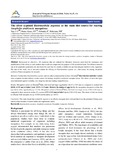The silver cyprinid Rastrineobola argentea as the main diet source for rearing Anopheles arabiensis mosquitoes

Date
2014Author
Yugi, J O
Otieno-Ayayo, ZN
Ochanda, H
Mukabana, W R
Language
enMetadata
Show full item recordAbstract
Background & objectives: All organisms that are cultured for laboratory bioassays need food for sustenance and amplification of the colony to such numbers that would not compromise the progress of the research at hand. For effective turnover rate in the population generation, the diet should be such that it is readily available and provide adequate nutrients to the organisms. The aim of this study was to test and evaluate the efficacy of Rastrineobola argentea as a diet source for rearing Anopheles arabiensis Patton mosquitoes for research.
Methods: Crushed fish, Rastrineobola argentea and two other commercial larval feeds (TetraminÒ Baby fish food and baker’s yeast) were compared for their efficacy as diet sources for feeding Anopheles arabiensis mosquito larvae. The effects of these diet types were determined against fecundity, size, longevity and male mating competitiveness.
Results: Mosquitoes raised on TetraminÒ Baby fish food laid larger egg batches (66.45 ± 5.03 mm) as compared to crushed fish (64.86 ± 4.93 mm) or bakers’ yeast (50.49 ± 4.25 mm). However, the number of eggs laid by the mosquitoes irrespective of the diet type did no differ significantly (p < 0.132). Mosquitoes raised on TetraminÒ Baby fish food were larger in size (3.06 ± 0.02 mm) as compared to those raised on crushed R. argentea (2.93 ± 0.01 mm) or baker’s yeast (3.00 ± 0.02 mm). The choice of diet was found to influence both mosquito size (p < 0.001) and fecundity (p < 0.013).
Conclusion: This study found that crushed R. argentea is an effective mosquito larval diet and that it has the potential of being more effective than tetramin if refined further and supplements added.
Citation
Yugi, J. O., Otieno-Ayayo, Z. N., Ochanda, H., & Mukabana, W. R. (2014). The silver cyprinid Rastrineobola argentea as the main diet source for rearing Anopheles arabiensis mosquitoes. Journal of Mosquito Research, 4(1).Publisher
University of Nairobi
